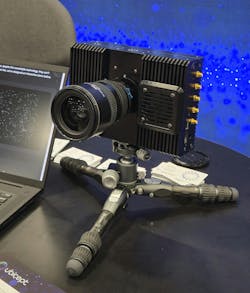SPAD-Based Camera Delivers High Dynamic Range Video
What you'll learn:
- What is a single-photon avalanche diode (SPAD) sensor?
- Why are SPADs important?
- How do SPADs work?
Single-photon avalanche diode (SPAD) sensors are photodetectors that generate a pulse when they detect a photon. SPADs are often used with LiDAR and time-of-flight (TOF) imaging systems. They tend to be very sensitive, allowing for low-light operation. The event-based nature of the diodes makes the output amenable to artificial-intelligence (AI) models connected to spiking neural networks (SNNs) that support neuromorphic computing, such as technology available from BrainChip.
I talked with Dr. Sebastian Bauer, CEO at Ubicept, about the company’s flexible light acquisition and representation engine (FLARE) smart camera that combines SPAD sensors with a GPU (Fig. 1). It delivers a video stream that exceeds the quality of conventional high speed, low light imaging systems. The GPU, which can also provide real-time AI analysis of the video stream, can be programmed to handle tasks like high-speed analysis, gated imaging, 3D perception, and even indirect sensing.
This type of camera is useful for many applications including automotive advanced driver-assistance systems (ADAS), in which the camera needs to operate in low-light environments (Fig. 2). Conventional cameras tend to provide lower-quality images because of tradeoffs and the frame-by-frame implementation.
SPAD systems have the advantage of providing an extremely high dynamic range. This is key in ADAS applications, where glare from lights and the sun can easily block out details when viewed from a video captured by a conventional, frame-based CMOS sensor.
The SPAD runs as an event-based sensor and the GPU can be used to generate a high-quality, frame-based data stream that would work with conventional AI models. It could also run an SNN, which tends to be more power-efficient.
The demonstration camera (Fig. 3) is large compared to what’s needed for most automotive applications. It’s designed for prototyping and evaluation, but a production system is considerably more compact.
About the Author
William G. Wong
Senior Content Director - Electronic Design and Microwaves & RF
I am Editor of Electronic Design focusing on embedded, software, and systems. As Senior Content Director, I also manage Microwaves & RF and I work with a great team of editors to provide engineers, programmers, developers and technical managers with interesting and useful articles and videos on a regular basis. Check out our free newsletters to see the latest content.
You can send press releases for new products for possible coverage on the website. I am also interested in receiving contributed articles for publishing on our website. Use our template and send to me along with a signed release form.
Check out my blog, AltEmbedded on Electronic Design, as well as his latest articles on this site that are listed below.
You can visit my social media via these links:
- AltEmbedded on Electronic Design
- Bill Wong on Facebook
- @AltEmbedded on Twitter
- Bill Wong on LinkedIn
I earned a Bachelor of Electrical Engineering at the Georgia Institute of Technology and a Masters in Computer Science from Rutgers University. I still do a bit of programming using everything from C and C++ to Rust and Ada/SPARK. I do a bit of PHP programming for Drupal websites. I have posted a few Drupal modules.
I still get a hand on software and electronic hardware. Some of this can be found on our Kit Close-Up video series. You can also see me on many of our TechXchange Talk videos. I am interested in a range of projects from robotics to artificial intelligence.



